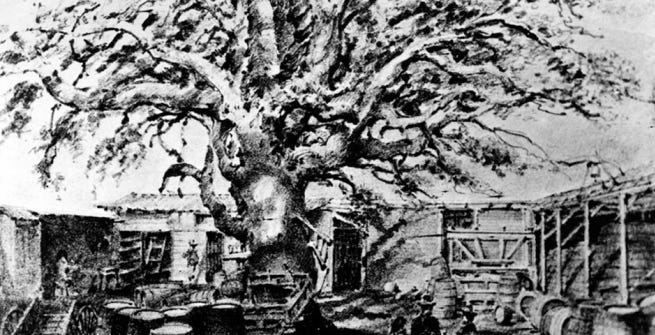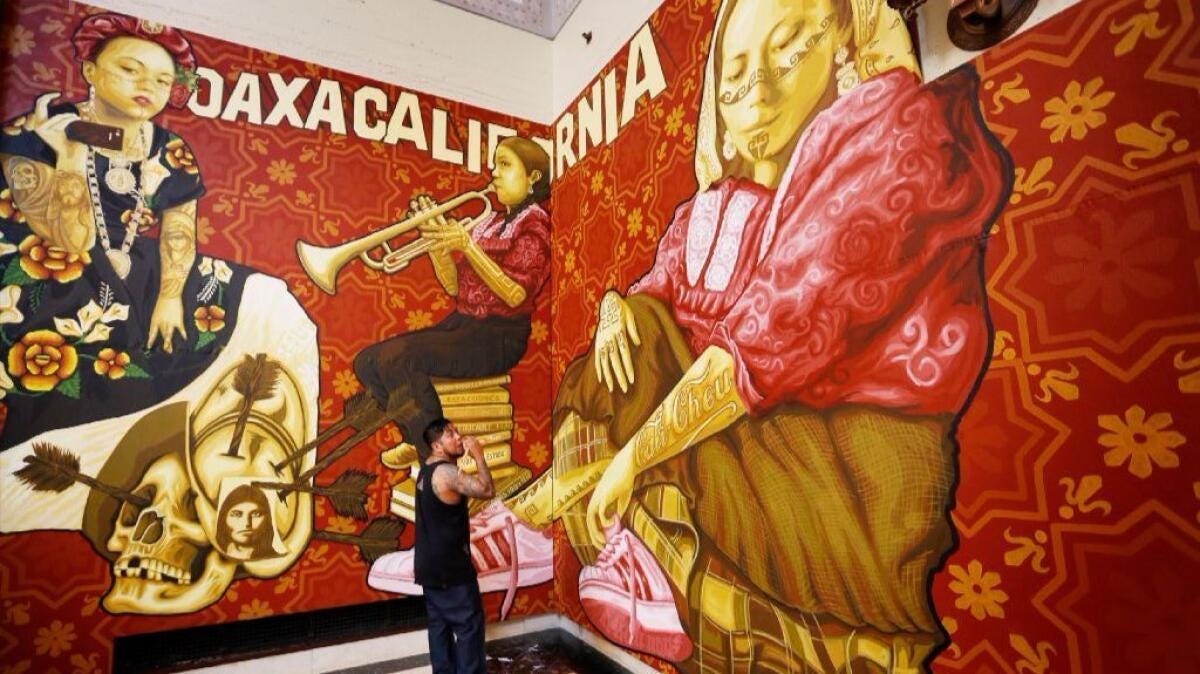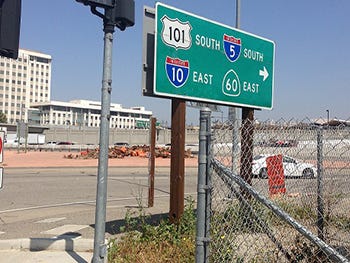This Occupied Land
Origins, Presence, Looking Ahead
Notes from the Inflection Point explores ways to process and express climate-related emotions like love and fear together. With a voice dedicated to seeing things afresh, again, and with agency, we offer readers reflections most Thursdays.
Note: this is an abridged version of an essay that appeared in Light Hive earlier this week.
The essay that follows is about how land and embodiment are natural extensions of each other. Life makes space a place.
Where Land Came From
First, there was chaos. Then, there was song and dance.
Today, this body writes from the unceded territories of the Tongva peoples called “Tovaangar,” meaning “the world.” The Tongva have been indigenous to the Los Angeles Basin for close to 7,000 years, with their creation, of course, narratologically preceding them.
In the Tongva tradition, Quaoar (“qwah-o-arr”) is the primary creator god. Through dance, alchemy, and a Song of Creation, he first created the God of the Sky, Weywot, then Chehooit, the Goddess of the Earth. Earth and Sky came together to make sun (Tamit) and moon (Moar).
Through celebratory ritual, they co-created animals, plants, people, and other gods. As with Old Testament mythology, celestial beings created land, plants, and animals first. Original land inhabitants, other than the trees, reefs, and rivers, were deer, antelope, coyotes, mountain lions, grizzly bears, and even woodpeckers.
Then, the gods danced Tobohar (man) and Pahavit (woman) into creation. Humans represented one, derivative strand of life, dependent upon the earth, sky, and life that preceded it.
To Ground our Bodies
As above, so below: life is chaos and dance.
Embodiment, dropping into our sensory experience, has always been environmental and relational. Stated differently, we are always already embedded in the elements. We don't need to “get” grounded—though I also often use this language—so much as remember our connection.
Consider how a “grounding” meditation might begin with the surfaces around you. We “settle in” to our environmental situatedness. The floor. The cushion. And then, often, a teacher will invite awareness of breath, air, and sounds around us.
In Embodied Activism, Rae Johnson writes of phenomenology—the study of the felt senses. We shape and are shaped by our environments. The bolded bits emphasize that the environment is never not part of our bodies, because bodies are defined by the environment.
Our body image is the corporeal schema or map that unconsciously structures our perceptions, movements, gestures, posture, and sense of position in relation to the environment; in short, it accounts for our way of being in and through the body. […] the strength and clarity of the mind/body/environment relationship is not a given; rather, it needs to be cultivated through embodied praxis.
Through embodied praxis, the balance between felt sense and environment, we transform abstract space into meaningful place. We can turn our bodies into home—understanding that bodies, like land, are susceptible to aging, illness, and death, just on different timelines.
“I came to inspire”
Embodied praxis is environmental praxis—remembering our inseparability from the land that holds us.
Gabrielino tribes, of which the Tongva was one major member, intermarried, sometimes had conflicts (it’s human), but otherwise co-existed for millennia.
What is now downtown had a large concentration of Tongva peoples because it was originally the site of Yaanga, a large Tongva village. The center of the village was a powerful sycamore tree that stood over 60 feet tall: a sibling to the people, caretaker, shelter, and symbol of restorative life.
In 1769, Gaspar de Portolá “discovered” and enslaved the Tongva. Spanish missionaries turned their village into a prison and slave labor market. The Tongva exchanged labor for bail money (for crimes like being unhoused), a system that didn't exist prior to the privatization of land and classification of bodies.
The missionaries gave the tree at the Tongva village a Spanish name: El Aliso. By the mid-1800’s, a vineyard would be built around it.


The tree was eventually cut down to make space for this:
CW/TW: brief reference to sexual assault. If you’d like, you can skip to the red picture below/next section.
This took place over centuries but some saw this trajectory quite early on.
Seventeen years of violence and land abuse, in 1786, Toypurina had gathered various Gabrielino tribes (of which the Tongva were one) to rise up and fight the Christian slavers. Being a sister to the Tongva chief was likely helpful in establishing her credibility as a leader in the patriarchal culture, though her shamanistic powers were independently revered.
Unfortunately, her plan to kill the Christian missionaries failed and, more, led to her being caught and jailed.
Tongva belief systems maintain animals, land, wind, all had human characteristics with agency. Like their human siblings, they communicated frustration, generosity, anger. And fire could still be channeled while handcuffed, standing before a judge with laws you do not subscribe, in a room built upon stolen land.
At her trial: “I hate the padres and all of you, for living here on my native soil, for trespassing upon the land of my forefathers and despoiling our tribal remains.”
According to Weshoyot Alvitre, Tongva member and transformative justice scholar, Toypurina witnessed their arrival to this pristine, self-regenerating land when she was just ten years old. She witnessed the violence, displacement, subjugation, enslavement, and destruction of her land and peoples. There are records of her witnessing the sexual assault of women in her village as a child.
“I came to inspire the dirty cowards [Gabrielinos] to fight, and not to quail at the sight of Spanish sticks that spit fire, and not to retch at the evil smell of gunsmoke—and be done with you white invaders!”
Records reflect that her disdain for fellow indigenous peoples who converted to Christianity was equal to that which she held for the colonizers themselves. Trading present-day, individual comforts and the wine that helped them forget for all future siblings, children, was an earth-quaking betrayal that still reverberates today.
From abundance to ashes and a fearful cowardice she could not condone or follow. Seventeen years was enough.
Toypurina’s energy was known before her courtroom entry, hands restrained behind her back. It was not surprising the 24 year-old tribal leader would not sit on the provided stool.
She kicked it over, defiant.
She would stand as a mountain, in that courtroom and for generations to come.

Remembering a Broader Kinship
The web this body would like to call “home.”
Does being baptized while imprisoned less than a year later, by the person who she tried to kill, make Toypurina a Christian? Does paving over Tovangaar make it Los Angeles?
Is the 1-acre site returned to the Tongva in October 2022 enough to make up for what they continue to endure? This would be the first time they had land in Los Angeles county in over 200 years. A couple months ago, another half-acre was returned to another Gabrielino tribe (often generalized as Tongva).
I don’t think so. But we can’t change the past.
So the question becomes: what future will you leave behind you, when everything is over?
⛰️Creative Coalition: The Ground Itself — September 21, 10-12:30 PT
A place-making game about the echoes and traces we leave for others after we are gone.
You walk past the same corner every day. But what about ten years ago? Was that corner there 100 years ago? What stories would the land tell about 1,000 years from now?
Over 2.5 hours, I'll guide you through the storytelling game The Ground Itself by Everest Pipkin. Come talk change, memory, and the ground itself.
The vast majority of Creative Coalition offerings have been writing games, essentially shared solo play. September’s CC will be a structured conversation limited to five players. We’ll open with a meditation, include one screen break, and debrief at the end.
September 21, 10-12:30 PM PT
Limit 5
Base price: $150
Some seats will always be free for the curious or cash-strapped. There are two full scholarships this month. Email or DM to claim them.
Paid subscribers get 50% off using the code in the chat.
🏔️ Ready to make space a place? Sign up here!
Bio
Logan Juliano, PhD (they/them) is a queer, transracial adoptee with a PhD in Performance Studies and lecturer at the University of California, Los Angeles. They do all the Light Hive things, co-edit Notes from the Inflection Point, where they write to share reflections and practices amid ecological and social uncertainty. Today they are grateful for carpools.



